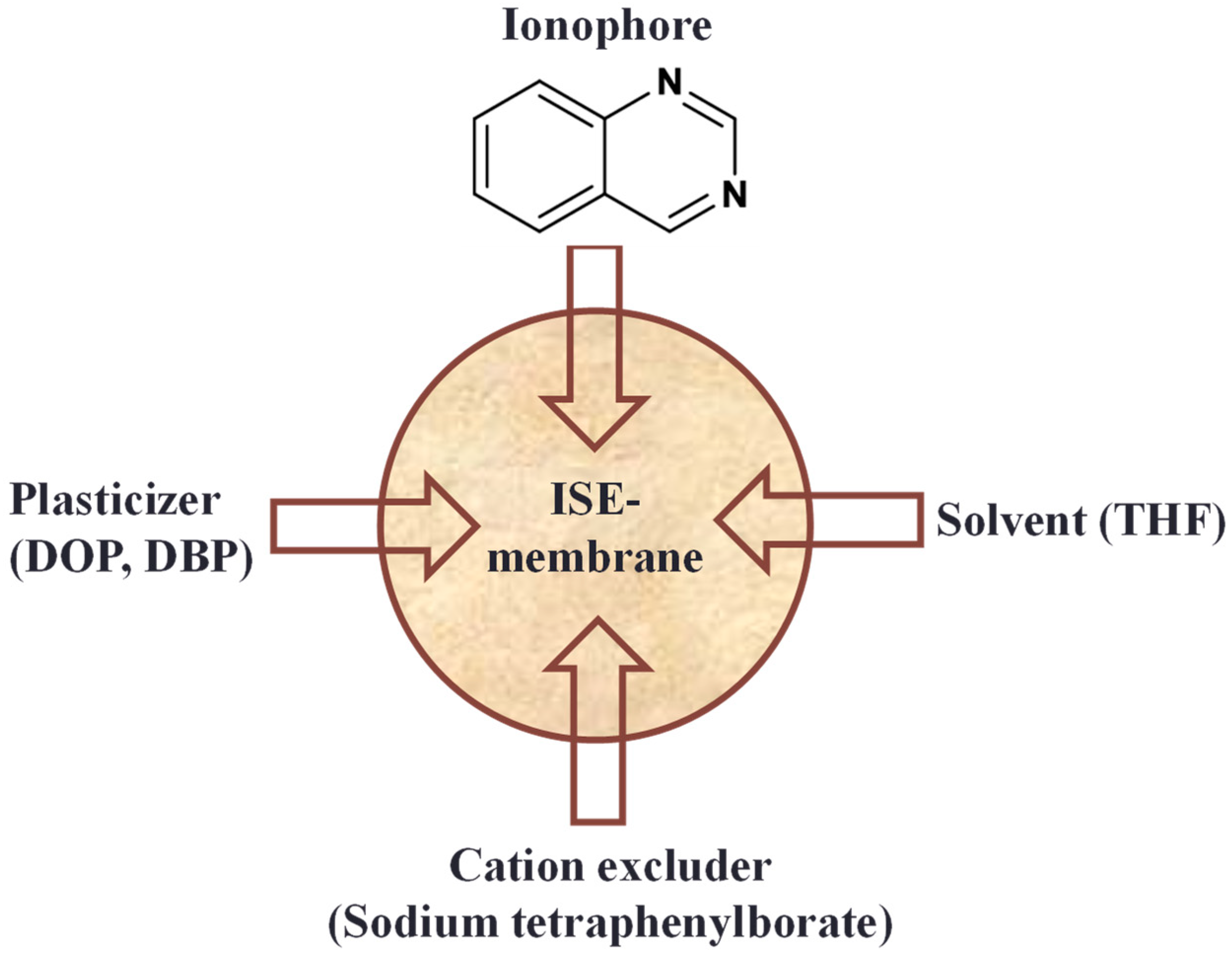Ion-Selective Electrode (ISE) Based on Polyvinyl Chloride Membrane Formed from Heterocyclic Quinazoline Compounds as Ionophore material †
Abstract
:1. Introduction
2. Materials and Equipment
- PVC polymer;
- Ionophore specific to the target ion;
- Plasticizer (e.g., dioctylphthalate);
- PVC solvent (e.g., tetrahydrofuran);
- Internal electrode (usually a silver or silver/silver chloride electrode);
- Reference electrode (e.g., Ag/AgCl electrode).
2.1. Preparation of PVC Membrane
- Dissolve the PVC polymer in the solvent (tetrahydrofuran) to create a solution.
- Add the ionophore specific to the target ion into the PVC solution. The ionophore concentration should be carefully chosen based on the desired sensitivity and selectivity of the electrode.
- Add a plasticizer (e.g., tributylphthalate) to improve the flexibility and permeability of the membrane. The plasticizer helps to ensure that the membrane is more responsive to ion changes.
- Mix the PVC solution thoroughly to ensure the uniform distribution of the ionophore and plasticizer.
- Use membrane solution casting equipment to apply a thin layer of the PVC membrane solution onto the surface of the internal electrode.
- Allow the membrane to dry, creating a stable PVC membrane layer on the electrode.
2.2. Clinical Diagnostics
2.3. Environmental Monitoring
2.4. Pharmaceutical Analysis
2.5. Agriculture and Soil Analysis
2.6. Food and Beverage Industry
2.7. Biotechnology
2.8. Industrial Process Monitoring
Author Contributions
Funding
Informed Consent Statement
Data Availability Statement
Conflicts of Interest
References
- Monteiro, M.C.; Winiarski, J.P.; Santana, E.R.; Szpoganicz, B.; Vieira, I.C. Ratiometric Electrochemical Sensor for Butralin Determination Using a Quinazoline-Engineered Prussian Blue Analogue. Materials 2023, 16, 1024. [Google Scholar] [CrossRef] [PubMed]
- Zhang, Z.; Yuan, A.; Xu, H.; Wang, H.; Zheng, C.; Weng, Y.; Bai, Y.; Zhu, Q.; Zhong, B. A fluorescent sensor based on quinazoline ketone derivatives for selectivity of Fe3+. Int. J. Environ. Anal. Chem. 2015, 95, 650–656. [Google Scholar] [CrossRef]
- Ovádeková, R.; Jantová, S.; Labuda, J. Detection of the Effective DNA Protection by Quinazolines Using a DNA-Based Electrochemical Biosensor. Anal. Lett. 2005, 38, 2625–2638. [Google Scholar] [CrossRef]
- Selva Kumar, R.; Ashok Kumar, S.K.; Vijayakrishna, K.; Krishna, A.; Rao, C.B.; Sivaraman, N.; Sahoo, S. Development of highly selective potentiometric thorium(IV) ion-selective electrode: Exploration supported with optical and DFT analysis. Anal. Methods 2019, 11, 1338–1345. [Google Scholar] [CrossRef]
- Ganjali, M.R.; Norouzi, P.; Faridbod, F.; Riahi, S.; Yaftian, M.R.; Zamani, A.; Matt, D. Highly selective and sensitive Th4+-PVC-based membrane sensor based on 2-(diphenylphosphorothioyl)-N′,N′-diphenylacetamide. J. Appl. Electrochem. 2007, 37, 827–833. [Google Scholar] [CrossRef]
- Aghayizadeh, M.M.; Nasirizadeh, N.; Bidoki, S.M.; Yazdanshenas, M.E. Electrochemical Behavior of a Thio-Quinazoline Derivative Electrodeposited on a Glassy Carbon Electrode Modified with Multi-Wall Carbon Nanotubes: Application for Simultaneous Determination of Hydroxylamine and Nitrite. Int. J. Electrochem. Sci. 2013, 8, 8848–8862. [Google Scholar] [CrossRef]

Disclaimer/Publisher’s Note: The statements, opinions and data contained in all publications are solely those of the individual author(s) and contributor(s) and not of MDPI and/or the editor(s). MDPI and/or the editor(s) disclaim responsibility for any injury to people or property resulting from any ideas, methods, instructions or products referred to in the content. |
© 2023 by the authors. Licensee MDPI, Basel, Switzerland. This article is an open access article distributed under the terms and conditions of the Creative Commons Attribution (CC BY) license (https://creativecommons.org/licenses/by/4.0/).
Share and Cite
Mohan, C.; Robinson, J.; Negi, A. Ion-Selective Electrode (ISE) Based on Polyvinyl Chloride Membrane Formed from Heterocyclic Quinazoline Compounds as Ionophore material. Eng. Proc. 2023, 48, 10. https://doi.org/10.3390/CSAC2023-14914
Mohan C, Robinson J, Negi A. Ion-Selective Electrode (ISE) Based on Polyvinyl Chloride Membrane Formed from Heterocyclic Quinazoline Compounds as Ionophore material. Engineering Proceedings. 2023; 48(1):10. https://doi.org/10.3390/CSAC2023-14914
Chicago/Turabian StyleMohan, Chandra, Jenifer Robinson, and Arvind Negi. 2023. "Ion-Selective Electrode (ISE) Based on Polyvinyl Chloride Membrane Formed from Heterocyclic Quinazoline Compounds as Ionophore material" Engineering Proceedings 48, no. 1: 10. https://doi.org/10.3390/CSAC2023-14914
APA StyleMohan, C., Robinson, J., & Negi, A. (2023). Ion-Selective Electrode (ISE) Based on Polyvinyl Chloride Membrane Formed from Heterocyclic Quinazoline Compounds as Ionophore material. Engineering Proceedings, 48(1), 10. https://doi.org/10.3390/CSAC2023-14914







